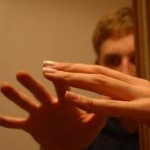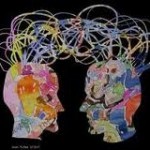
As we move through our lives our brains constantly interpret the actions and intentions of others. When we see someone pick up a stone, how do we know if it’s a threat?
We also learn from others and sometimes we feel for them. How do we learn by imitation? Why do we feel empathy?
The answers to these questions are found in brain research on neurons.

Giacomo Rizzolatti and his colleagues were studying brain activity in monkeys by implanting thin electrodes to take precise measurements of the brain’s electrical activity (EEG). They wanted to see what was happening in the brain before the observed beginning of a voluntary movement. The experimenter recorded activity while the monkey was taking a banana and bringing it to its mouth to eat. When the experiment ended, it was lunchtime for the experimenter and he took a sandwich from his lunch box and brought it to his mouth. The electrodes were still in the monkey’s brain and the recording continued to run. Then the experimenter realized that the recording showed something unexpected and very interesting. The same neurons that had been active when the monkey took the banana and put it to his mouth were active when the monkey observed the experimenter performing a similar action with the sandwich. The monkey’s brain was in a sense ‘mirroring’ the actions of the experimenter.
Mirror neurons exist in the pre-motor cortex, so-called because it shows electrical activity before the motor region (which shows movement) becomes active. During this phase the brain simulates the movement before actually performing it.
Since the research team’s initial discovery, other experiments by Rizzolatti have revealed that two simultaneous conditions must exist for mirror neurons to activate: there must be an object within the visual field (of the monkey, in this case) and there must be an agent using the object to achieve a goal. Mirror neurons did not activate in the pre-motor cortex when the experimenter brought an imaginary object to his mouth, or when the monkey saw food on the table but no one picked it up and prepared to eat it. Further experiments showed that one group of neurons were active when the monkey grasped an object to place it in a container, and another group of neurons activated when he grasped a piece of food to eat it. Although the initial act was the same (grasping) the second act was different (placing or eating). This showed that mirror neurons can play an important part, not only in understanding actions and goals, but they could be the underlying mechanism for the understanding of intentions.

Let us consider a knife. If you hold it to peel an apple, your hand will assume a certain position. If you hold the same knife to stab someone, you will hold it very differently and anyone whose mirror neuron system is working will understand your intention and anticipate your action. Therefore, the mirroring of another’s actions confers a survival advantage: being aware as early as possible of someone else’s threatening intentions offers a better chance of escape. It is not surprising that this mechanism was retained, and perhaps strengthened, through the transmission of genes from one generation to another.
Mirror neurons help to explain how we learn. A baby seeks the gaze of his mother and imitates her motor acts and those of others. By imitation and trial and error the child learns the consequences of both his own and others’ motor acts and chooses efficient ones for himself.
Andrew Meltzoff, a developmental psychologist at the University of Washington and co-author of The Scientist in the Crib: What Early Learning Tells Us about the Mind, found that infants as young as two weeks old can imitate simple actions such as moving a finger or sticking out a tongue. “Babies don’t become social,” Meltzoff says, “they’re social at birth.”[i]
There have been many studies of mirror neurons on humans. Marco Iacoboni, director of the Transcranial Magnetic Stimulation Lab at University of California, Los Angeles, and author of Mirroring People: The New Science of How We Connect with Others[ii], helped design a research project in which subjects observed three kinds of stimuli: a teapot, teacups and cookies; a teapot, teacups and cookies with a hand reaching as if to pour the tea; a teapot, teacups and cookies with a hand reaching as if to clean the teacup. The pictures with the implied action of the hand showed significant mirror neuron activity, while the picture of the items without a hand did not. Researchers concluded that the brain inferred intention based on the action. As the abstract states: “Understanding the intentions of others while watching their actions is a fundamental building block of social behavior….To ascribe an intention is to infer a forthcoming new goal, and this is an operation that the motor system does automatically.”
Mirror neurons also provide an understanding and sharing of emotions. Rizzolatti and his team studied the emotion disgust with a population of healthy volunteers. In a first series of tests, subjects had to smell several pleasant and unpleasant odors. In the second series, they had to watch videos recording the face of others smelling the same odors. As in the case of actions, the patterns of activities were the same during the experience of disgust and during the observation of faces expressing disgust.
Clearly, mirror neurons play an important, but unconscious, role in our social lives.
When Mirror Neurons Go Bad
As with other brain mechanisms, mirror neurons can be badly regulated, and malfunctioning of the mirror neuron system is a plausible explanation for severe disorders like schizophrenia, echopraxia (involuntary repetition or imitation of the observed movements of another) and autism. Iacoboni and Mirella Dapretto published research in 2006 that demonstrated a deficit in mirror neuron activity in children with autism. Among 20 study subjects, half had autism.
“The subjects saw 80 pictures of faces expressing anger, fear, happiness, sadness, or nothing in particular,” says Iacoboni. “The researchers asked some subjects to merely view the faces and others to imitate them. In the group of autistic children asked to imitate the faces, the researchers found no activity in brain regions associated with mirror neurons…The more severe the condition, the less active the mirror-neuron system seems to be.”[iii]
No doubt, research will continue to unravel the mystery of mirror-neurons and their role in various social interactions. How much and how often are we virtually in the minds of others, anticipating their actions and perhaps picking up on their moods and stresses? And does the mind selectively choose to mirror or not mirror, depending on circumstances? As with every area of brain research, we are only beginning to understand this exciting field.
About the authors:
Pierre Bohn was the director of research for a French aeronautics company. Now retired, he is writing a book on the basic mechanisms of the brain and the efficiency of neurofeedback and the NeurOptimal method.
Corinne Fournier was the head of a research team in cognitive science for a French aeronautics company. She is now a NeurOptimal trainer and has trained many trainers and families of disabled children.
